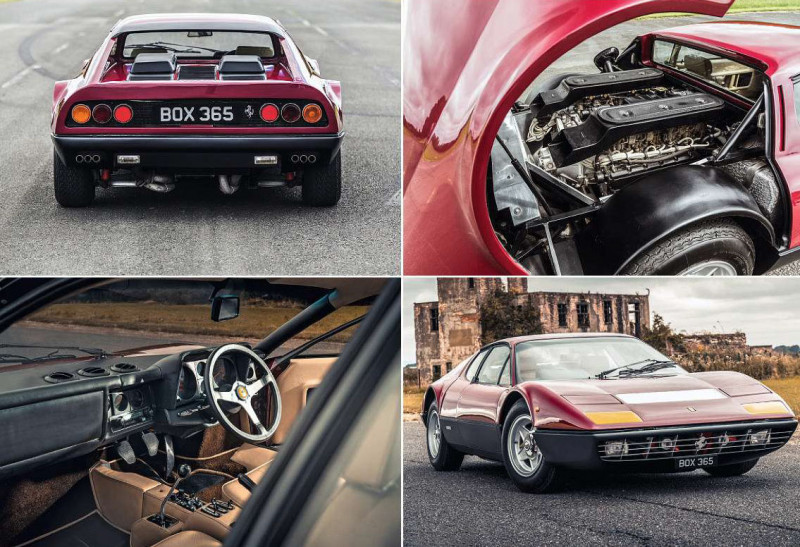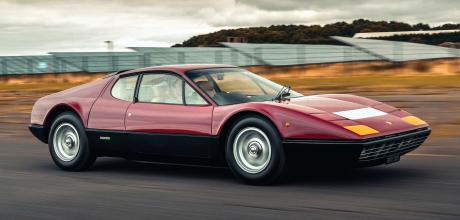1973 Ferrari 365GT4 BB
In the BB’s earliest form there is a simplicity and purity to the shape that later derivatives were never quite able to match’
Our first Ferrari entry here was not only the fastest car of the 1970s (based on the factory’s own claim of 188mph), but a significant one because it marked the start of a mid-engined era for Maranello’s 12-cylinder, two-seater cars that was to endure for nearly a quarter of a century.
The stars had clearly aligned when Ferrari introduced the prototype 365GT4 BB at the 1971 Turin Salon. There was already precedent for its decision to go mid-engined, with the 1967 Dino 206 (and later 246) so configured. And it would have been impossible for Ferrari to ignore that its four-year-old, front-engined 365GTB/4 Daytona had always been head-to-head with Lamborghini’s mid-engined Miura, then the epitome of advanced automotive engineering. It wasn’t as if a Ferrari with a 12-cylinder motor mounted amidships was a new concept. The benefits in terms of sharper handling and superior aerodynamics of an engine located aft of the cockpit had been proved since 1964 in Maranello’s 512 racer. It also pioneered a new engine design: Ferrari was the first car maker to employ a ‘flat’, or horizontally opposed, 12-cylinder unit, the packaging of which would have been impractical in a front-engined racer.

When the production-ready 365 Berlinetta Boxer arrived in 1973, this technology was fully embraced. In effect a wide-angled vee, with 180º separating each bank of cylinders, its all-new 4.4-litre flat-12 produced a solid 380bhp at 7200rpm and 301lb ft of torque at 3900rpm. It was a wide unit, but the configuration kept mass lower down in the chassis, although with its transaxle mounted below, beside the wet sump (a dry sump didn’t appear until the later 512BB), that advantage was never fully exploited.
In the BB’s earliest form there is a simplicity and purity to the Pininfarina-penned shape that later derivatives were never quite able to match. Based on the coachbuilder’s 1968 P6 concept car, it was shorn of all unnecessary addenda. A low, slender nose, with pop-up headlights and possibly the largest indicator lenses ever seen, housed a shallow radiator and small ‘frunk’, suitable only for overnight luggage. Avoiding the need for unsightly side-scoops, an aileron was neatly integrated into the rear roofline, overlapping the Boxer’s vertical back window and delivering air to four triple-choke Weber carburettors. Ironically, the 365’s trademark six tail-lights and sextet of peashooter exhausts were never part of the prototype’s design, which had four of each, just like the later 512.
‘Our’ 365 BB is rather special, having been Ferrari’s 1975 British motor show car. It’s wide even by modern standards, with hardly a flat surface adorning any panels, themselves sumptuously curved and neatly proportioned compared with those of Lamborghini’s Brutalist period rival, the wild Countach. Those scoopless flanks are unspoilt by mirrors or doorhandles, the latter being replaced by short ‘fingers’ that pull back from the base of the windowframes to gain entry. And any Ferrari that rides on classic Campagnolo alloys – especially if they’re shod with period-style 215/70 Michelin XWXs – is proper in my book. Entry over a wide sill puts you satisfyingly close to the car’s centre line and perched on a leather chair that demands only a slightly long-armed, short-legged position behind the non-standard three-spoke steering wheel. As is the norm for Ferrari two-seaters from this era, only dials populate the upper dashboard – eight of them in this case – with the heater controls (including optional and working air-con) and electric-window switches all consigned to the narrow, leather-trimmed central gear tunnel.
Fire up the engine from cold with a conventional turn of the key, and the initial rip-snort from the Webers is quickly replaced by a smooth and cultivated 12-pot timbre. Select the dogleg first in the traditional open-gated ’box and, other than getting used to a quite sticky throttle action, all the main controls are light and linear.
The cabin is bright and airy, with great vision all round, including over the low scuttle and through the pillar-box slot of a rear window. Who needs door mirrors? Wait for the oil to warm through and then push hard on the long-travel throttle. The Webers clear their throats and the engine note hardens into a trumpeting roar as the tacho’s needle reaches for its 7600rpm redline and a good deal of those 380 horses are unleashed. As we lap Prestwold, clipping just shy of 100mph down the straights, I’m barely flexing my right foot once up to speed: there’s so much more to explore, if only we had the space. The steering is deliciously light, telegraphing every nuance of the track’s surface through the wheel’s rim. You can’t avoid comparing it with the Miura and concluding that, if you had to traverse whole countries in the 1970s, this would have been your weapon of choice, with its easy-going savoir faire and abundant reserves of power to banish any contender from its rear-view mirror.
Thanks to Simon Drabble Cars (07584 243004; simondrabblecars.co.uk) and Guy Newton
TECHNICAL DATA FILE 1973 Ferrari 365GT4 BB
- Sold/number built 1973-’1976/387
- Engine all-alloy, dohc-per-bank 4391cc flat-12, four triple-choke Weber 40IF3C carburettors
- Max power 380bhp @ 7200rpm
- Max torque 301lb ft @ 3900rpm
- Transmission five-speed manual transaxle, RWD
- Suspension independent, by double wishbones, coil springs (twin at rear), telescopic dampers, anti-roll bar f/r
- Steering rack and pinion
- Brakes ventilated discs, with servo
- Weight 3420lb (1551kg)
- 0-60mph 6.5 secs
- Top speed 188mph
- Price new £14,255
- Price now £200-350,000
Clockwise: lights and tailpipes follow rule of six; 4391cc flat-12 gives 380bhp; low nose houses enormous indicators; vision is surprisingly.
LAND SPEED RECORD ON A BICYCLE 139mph
Okay, so this is ‘motor-paced’ (with a vehicle running ahead to deflect wind from the cyclist), but in 1973 motorcycle racer Dr Allan Abbott managed a huge 139mph on the Bonneville Salt Flats behind a specially adapted 1955 Chevrolet pace car. In ’78, someone tried to break his record behind a Porsche 935, but the bicycle’s tyre blew at 105mph…


